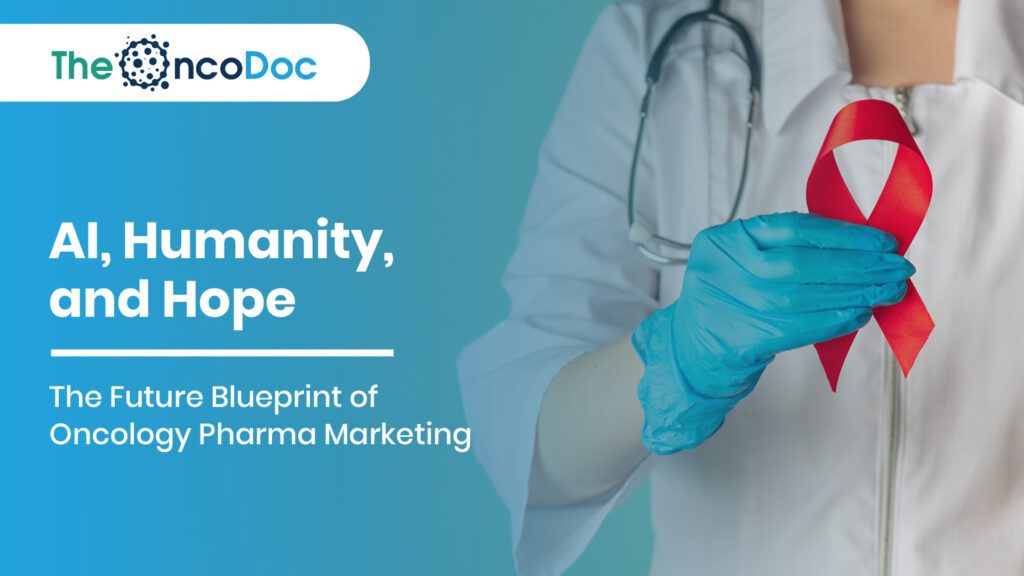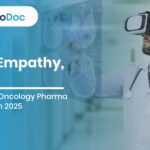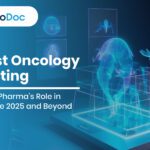Introduction: From Selling Drugs to Saving Journeys
Oncology has entered a watershed moment. Cancer is no longer just a disease treated with chemotherapy and radiation, it is an arena of personalized medicine, immunotherapies, gene-editing breakthroughs, and AI-driven diagnostics. As treatment pathways become more individualized, so too must the strategies of pharma marketing.
The pharma marketer’s role has evolved from being a promoter of drugs to becoming an educator, ecosystem builder, and trust architect. Oncology patients are not passive recipients of care; they are active participants who demand information, reassurance, and hope. With cancer incidence projected to rise globally by 47% by 2040, the pressure on pharma companies is immense, not only to innovate in laboratories but also to innovate in communication, access, and equity.
This article explores the emerging trends, strategies, and technologies that are reshaping oncology pharma marketing in 2025. It dives into how data intelligence, AI, and empathy-driven narratives are creating a new era of patient-first marketing.
1. The Shift to Humanized Oncology Campaigns
Traditional pharma marketing prioritized physicians, but in oncology, the decision-making web is far more complex. Patients, caregivers, oncologists, and even survivor communities influence choices. Empathy, narrative, and empowerment are the cornerstones of campaigns in 2025.
Key strategies include:
- Narratives of survivorship that provide emotional reassurance.
- Culturally adapted content that reduces stigma and makes therapies approachable.
- Visual-first education such as explainer videos and infographics for better comprehension.
Humanizing campaigns ensures patients don’t feel like “cases” but rather individuals navigating one of the toughest journeys of their lives.
2. AI-Driven Precision Targeting
Cancer patterns are not universal. A lung cancer awareness drive in urban Tokyo will differ from an oral cancer campaign in rural Uttar Pradesh. Marketers now leverage AI-powered segmentation models that map:
- Cancer prevalence data across geographies.
- Digital health behavior, such as symptom-related Google searches.
- Socioeconomic barriers impacting screening participation.
This makes hyper-localized, predictive advertising possible, delivering the correct message to the right people at the right moment.
3. Engaging General Practitioners as Gatekeepers
General Practitioners (GPs) are often the first line of detection, yet many lack oncology-specific training. Pharma companies are addressing this gap through:
- WhatsApp-based CME modules for bite-sized learning.
- Diagnostic referral toolkits simplifying decision-making.
- AI-powered alerts that recommend region-specific cancer screenings.
These approaches transform GPs from passive referrers to active oncology allies.
4. Omnichannel Engagement for Cancer Awareness
Pharmaceutical brands are no longer able to rely just on one channel. Instead, omnichannel strategies are key:
- Instagram reels and YouTube shorts featuring survivor-led awareness stories.
- Screening reminders delivered via apps and SMS.
- Interactive kiosks in clinics offering AI-based symptom checkers.
Omnichannel ensures consistency, whether a patient hears about a campaign online, in a doctor’s office, or at a community event, the message stays uniform.
5. Behavioral Nudges for Early Screening
One of oncology’s biggest challenges is late diagnosis. To shift behavior, marketers are applying behavioral science principles:
- Automated nudges (e.g., “It’s been a year since your last mammogram, book now”).
- Gamified screening challenges where communities compete for free health checkups.
- Reward incentives like free consultations for participation.
These tactics improve early detection rates, making campaigns measurably life-saving.
6. Storytelling That Heals, Not Sells
Pharma brands are reframing their identity, not as pill providers but as companions in survivorship journeys. Survivor-led storytelling campaigns have demonstrated:
- 38% higher engagement compared to generic awareness ads.
- Stronger trust in pharma brands when real patient voices are highlighted.
- Increased participation in local screening camps.
Emotional storytelling provides a halo effect of credibility and relatability.
7. AI-Powered Personalization in Oncology Marketing
Gone are the days of mass campaigns. With AI, oncology marketing is now individualized:
- A smoker in India may receive localized oral cancer prevention videos.
- A woman in her 40s searching “breast lump” might get AI-curated self-exam tutorials.
- A caregiver browsing chemotherapy side effects may see targeted nutritional support content.
AI ensures the message resonates personally, increasing conversion from awareness to action.
8. The Power of Vernacular and Hyperlocal Messaging
Cancer communication fails if it ignores cultural and linguistic nuances. In India, for instance:
- Tamil-language videos on breast cancer resonate more deeply than English leaflets.
- Assamese folk songs on oral cancer reach more rural audiences than digital ads.
Campaigns that are hyperlocal and vernacular increase impact, understanding, and trust.
9. Digital Tools for Oncologists: Beyond Prescriptions
Pharma is building digital ecosystems for oncologists, including:
- AI-curated research digests.
- Patient monitoring dashboards tracking adherence.
- Collaborative forums for case sharing.
This transforms pharma from drug supplier to knowledge partner, elevating credibility.
10. Redefining Metrics: From Vanity to Value
In oncology, clicks and impressions mean little. The new KPIs are health-first:
- Screenings booked.
- GP referrals made.
- Chatbot interactions for triage.
- Survivorship community participation.
These metrics measure real health outcomes, not empty engagement.
11. KOLs and Survivor Influencers as Trust Anchors
Key Opinion Leaders (KOLs) are no longer just top-tier oncologists, they include survivors, caregivers, and grassroots health workers. Micro-influencers in regional communities have 10x higher engagement than national campaigns because they speak the language of lived experience.
12. Predictive Campaigns with AI Surveillance
By analyzing search terms, hospital intake data, and social chatter, AI now predicts cancer hotspots. Example: For instance, a district may launch micro-campaigns for lung cancer screening if there is an unexpected increase in searches for “persistent cough.”
13. Gamification as a Tool for Awareness
Engagement in oncology is hard, but gamification adds motivation and curiosity:
- Health score quizzes.
- Screening challenges between districts.
- Social achievement badges for participation.
Gamification increases campaign participation by up to 30%.
14. Wearables and Integrated Health Data
Smartwatches and health trackers now feed into oncology prevention campaigns. Examples:
- Abnormal heart rate alerts triggering educational notifications.
- BMI drops linked to cancer awareness reminders.
- Wearable data integrated into pharma apps for personalized nudges.
This ecosystem blends digital health with preventive oncology.
15. Public-Private Partnerships for Broader Impact
Pharma firms now collaborate with local health organizations, governments, and NGOs:
- Co-sponsoring national screening camps.
- Training community health workers with branded materials.
- Running public health campaigns during national cancer days.
Partnerships multiply reach while reducing marketing costs.
16. Virtual Oncology Communities for Engagement
Digital communities act as safe spaces where patients connect, share, and heal. Pharma brands nurture these groups by:
- Hosting oncologist Q&A sessions.
- Offering peer counseling in vernacular languages.
- Facilitating resource-sharing platforms.
These communities double as feedback loops for campaign effectiveness.
17. Voice-Tech in Oncology Outreach
Voice search and IVR systems are bridging literacy gaps. For example:
- Voice-enabled WhatsApp symptom checkers.
- Regional IVR helplines for FAQs.
- Alexa/Google Assistant plug-ins for cancer awareness.
Voice-based outreach ensures inclusivity in rural and low-literacy populations.
18. Sentiment Analysis for Emotional Alignment
AI sentiment analysis tools now evaluate campaign tone. If patients express fear, messaging is adjusted to softer, empathetic tones. Survivor-led videos often outperform statistics-heavy ads. This ensures campaigns stay emotionally aligned with their audiences.
19. Survivor Clubs as Authentic Outreach Engines
Survivor networks are becoming grassroots influencers. These clubs host school and workplace awareness workshops, organize local events, and provide first-hand testimonies. Peer-driven credibility is unmatched, especially in oncology.
20. AR/VR for Training and Patient Comfort
Pharma brands are leveraging AR/VR in two ways:
- Oncologist training through 3D tumor models and surgical simulations.
- Patient reassurance via VR demos showing how targeted therapies work safely.
This blend of science and empathy builds confidence in cutting-edge therapies.
21. Chatbots as 24/7 Oncology Allies
Smart chatbots guide patients in:
- Self-assessments.
- Finding nearby diagnostic centers.
- Booking consultations.
By offering round-the-clock triage, chatbots make oncology more accessible.
22. Fighting Misinformation with Social Listening
Cancer myths, like “herbal cures” or “chemotherapy always kills”, spread rapidly online. Pharma marketers now deploy AI-powered listening tools that:
- Detect misinformation trends.
- Launch instant myth-busting posts.
- Equip KOLs with fact-based counters.
This approach safeguards trust and credibility.
23. Post-Treatment Engagement: Beyond Survival
Marketing in oncology doesn’t stop at remission. Survivorship care is now a long-term engagement strategy:
- Nutritional programs.
- Psychological wellness webinars.
- Digital side-effect trackers.
Patients remain connected to brands well beyond treatment, ensuring loyalty and trust.
24. The Future: Predictive, Preventive, and Personal
The next decade of oncology marketing is AI-first, empathy-led, and outcome-driven. Expect to see:
- Digital twins for therapy simulations.
- AI-driven symptom detection years before diagnosis.
- Emotion-based campaigns measuring hope, not clicks.
The brands that win will be those that blend science with soul, delivering not just drugs but lifelong health journeys.
25. Precision Marketing Through Genomic and Biomarker Insights
As oncology treatments become more personalized through genomics, marketing strategies are also evolving. Patients today are increasingly undergoing genetic testing (e.g., BRCA1/2, EGFR, KRAS mutations) to determine therapy eligibility. Pharma marketers can no longer create one-size-fits-all awareness campaigns, instead, campaigns must align with genomic-driven personalization.
Examples include:
- Mutation-specific awareness campaigns, educating patients on why genetic testing matters.
- Doctor-focused genomic toolkits, simplifying complex biomarker-linked treatment decisions.
- Patient-friendly visuals, showing how targeted drugs work against mutations.
This integration ensures that pharma campaigns are not only scientifically accurate but also relevant to an individual’s medical reality, enhancing trust.
26. Ethical and Transparent Marketing in the AI Era
With AI analyzing sensitive patient data, oncology pharma marketing faces a new frontier of ethics and transparency. Patients are increasingly aware of data privacy concerns and expect pharma companies to act with integrity.
Forward-looking pharma marketers are embedding ethical practices into their campaigns:
- Transparent consent for AI-driven personalization.
- Transparent explanation of the collection and usage of data.
- Campaign messaging that avoids fear-based narratives, focusing instead on empowerment.
This builds long-term credibility, a critical differentiator in oncology, where trust is often as important as treatment.
27. Sustainability in Oncology Campaigns
Sustainability is no longer a corporate side-note; it is becoming a core pillar of marketing strategy. Oncology campaigns, which often involve large-scale events, printing, and field operations, are being re-imagined to reduce environmental footprints.
Practical applications include:
- Digital-first campaigns to cut down on physical brochures.
- Eco-friendly event management, using reusable materials at awareness drives.
- Partnering with green health organizations to showcase shared values.
For oncology patients and caregivers, sustainability signals responsibility and empathy beyond treatment. It positions pharma brands as not just healthcare leaders, but stewards of both health and environment.
28. Global Collaboration with Local Sensitivity
Cancer is a global epidemic, but solutions must be culturally and locally rooted. Pharma marketers are balancing global innovation with local adaptation:
- Global AI models are fine-tuned to local languages and cultural beliefs.
- Survivor ambassadors are chosen from within communities for authenticity.
- Awareness materials are co-developed with local NGOs to ensure accessibility.
This “glocal” approach ensures oncology campaigns are globally consistent yet locally resonant, creating higher engagement and adoption across diverse populations.
Conclusion: The New Age of Oncology Pharma Marketing
The evolution of oncology pharma marketing in 2025 represents a profound shift in philosophy. It is no longer about amplifying a product, it is about nurturing journeys, empowering communities, and saving lives. With the rise of AI-driven insights, genomic precision, survivor storytelling, ethical engagement, and sustainability, pharma companies are emerging as partners in care rather than promoters of drugs.
The future will be defined by precision (through data and genomics), empathy (through survivor voices and humanized content), and intelligence (through AI and predictive analytics). Campaigns that succeed will be those that bridge science with soul, addressing both the medical and emotional needs of patients.
Ultimately, oncology marketing’s true metric of success will not be ROI in prescriptions, but the return on impact, early diagnoses, improved adherence, equitable access, and longer, healthier survivorship journeys.
Pharma brands that embrace this transformation are not just marketing in oncology; they are reshaping the story of cancer care for the next generation.
The Oncodoc team is a group of passionate healthcare and marketing professionals dedicated to delivering accurate, engaging, and impactful content. With expertise across medical research, digital strategy, and clinical communication, the team focuses on empowering healthcare professionals and patients alike. Through evidence-based insights and innovative storytelling, Hidoc aims to bridge the gap between medicine and digital engagement, promoting wellness and informed decision-making.



